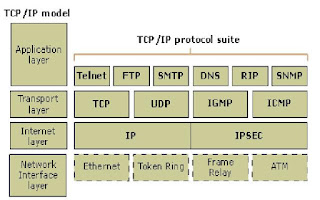Explain TCP/IP
Explain TCP/IP
TCP is an industry-standard protocol suite for Wide Area Networks (WANs) developed in the 1970s and 1980s by the U.S Department of Defense (DoD). TCP/IP is routable protocol that is suitable for connecting dissimilar systems (such as Windows and Unix) in heterogeneous network
It is the protocol of the world wide network Known as the Internet. the Internet began as a project founded by the United States Department of Defense in the 1970s to interconnect educational institutions and government installations. At that time, it was called ARPANET (Advanced Research Projects Administration Network). The Internet suite was developed about ten years before the OSI model was defined and can, therefore, be only roughly mapped to it. The Internet Protocol suite was defined according to its own model, Known as Internet and DoD model.
Note: The Internet protocol suite is unique in that it is the map of non-proprietary protocols. This means they do not belong to any one company and the technology is available to anyone who wishes to use it. The Internet Protocol Suite supported by the widest variety of network vendors.
The Four DoD Model Layers
- The network access layer corresponds to the physical and data link layers of the OSI model.
- The Internet layer corresponds to the OSI network layer. Protocol at this layer are concerned with transporting packet through the internetwork. The main Internet layer protocols is IP.
- The host-to-host layer corresponds roughly to the OSI transport layer. Protocols at this layer communicate with peer processes in other hosts or networked devices. An example of host-to-host protocol is TCP.
- The process /application layer correspond to the OSI session, presentation and application layers. Protocols at this layer applications services on the network. Example of protocols are Telnet (a terminal emulator) and FTP (File Transfer Protocol).
The IP suite does not include in lower-layer protocols, we shall discuss the individual protocols at the middle layers.
The OSI model's network and transport layers are concerned with transporting packets across the internetwork. TCP/IP and other IPs use three types of addresses for network addressing. some given are:
(a) Hardware or physical addresses are used by the data link and physical layers. Physically address are usually hard-coded into the network cards with each device.
(b) IP address provide logical node IDs. IP administrator according to certain guidelines. they are expressed in four-part dotted-decimal notation. For example, 123.122.121.13
(c) Logical nodes names are easier to remember than an IP address. For example, BANIYA.COM.


Comments